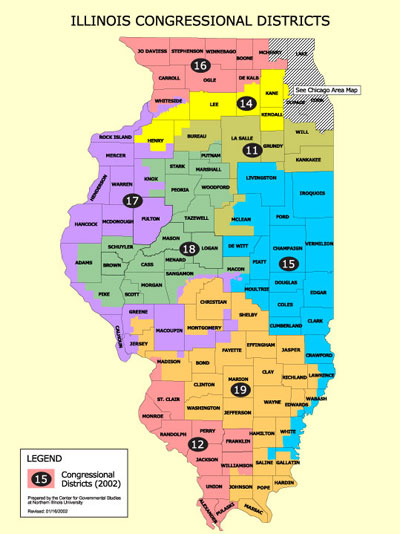I left the League of Women Voters meeting Saturday morning a little less hopeful than when I arrived. It’s not going to be easy to change minds in Springfield about the way the legislative districts are drawn. The meeting was dedicated to exploring ways we can make the districts contiguous and compact (as the Illinois Constitution demands), unlike they are now:

The suggested action plan, as proposed by former city councilman Bruce Brown, was to “let the sun shine in.” That may not sound like much, but the fact is that most people don’t realize just how ridiculous our districts are, and when they see them for the first time, they can hardly believe it. Brown mentioned that in Iowa, where their districts are now determined by an independent Legislative Support Bureau, agitation for change began with the Des Moines Register newspaper and some concerned citizens. He also cited the increased scrutiny congressional earmarks have been getting since that process was exposed. We need to get as many people and groups as possible to see the outrageousness of the current Illinois districts, and then get those people and groups to write their legislators demanding change. If enough constituents put pressure on them, legislators will respond.
Perhaps more difficult, but more importantly, we need to hold those legislators accountable. The reason these gerrymandered districts work, as Jim Thomas pointed out, is because our voting habits are so predictable. To have real change, we’re going to have stop rewarding gerrymandering politicians with our votes.
Another possibility, but one the League seemed loathe to attempt, is to vote for a constitutional convention for Illinois in 2008. The question of whether a constitutional convention should be called must appear on the ballot at least once every 20 years, according to the Illinois Constitution. The last time a constitutional convention was on the ballot was 1988, when it was soundly defeated (only 19% voted for it). The problem with a convention is that the whole Illinois Constitution is then up for grabs, and the League members fear that Illinoisans may lose more than they gain. Call it a healthy fear of the law of unintended consequences.
The legislative map is redrawn every ten years following the census, so the next scheduled redistricting will be voted on in 2011 and take effect in 2012. Unless anyone has a better idea, I say we get the word out and start putting as much pressure on our legislators as possible.

I’m seriously in favor of computer redistricting. It can be taught (er, programmed) to try to keep political or cultural units together (like counties, or townships, or regional areas without a distinct political boundary with a lot in common), but it won’t care how many republicans or democrats are in the district.
Turnover in the US Congress is substantially lower than it EVER was in the Supreme Soviet in the USSR. That’s right, a totalitarian one-party system had more turnover of incumbents who made their voting constituents unhappy than the world’s greatest democracy does.
I believe Schwartzenegger (sp?) is pushing for non-partisan, computer redistricting, which puts me in the slightly odd position of agreeing with him. 🙂
Even in this “revolutionary” year, 92% of incumbents kept their seats. I was amazed when I looked up Charlie Rangel’s numbers from this cycle to prove a point in a debate with Bill Dennis. He won with 94% of the vote in his district (New York’s 15th). Rangel’s held that district longer than I’ve been alive. Nobody should be that secure in their seat of power.
We Americans may have pioneered this idea of representative democracy, but I’m not sure we’re the ones who do it best anymore. There are so many factors corrupting the system these days. Even if we slay the gerrymander (which I agree is essential), we still have to tackle campaign financing and the exclusion of third party & independent candidates. This is a long, long road … but count me in.
Count me in, for sure. Those districts are crazy! And I thought Texas and Tom DeLay were the masters of this game… I hadn’t seen Illinois!